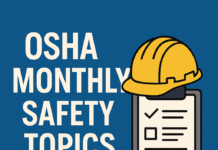
OSHA: Hazard Communication Standard 1926.59
Introduction to OSHA
The Occupational Safety and Health Administration (OSHA) plays a crucial role in ensuring workplace safety across various industries in the United States. OSHA sets forth regulations and standards aimed at protecting workers from occupational hazards, accidents, and illnesses.
Overview of Hazard Communication Standard 1926.59
Among OSHA’s regulations is the Hazard Communication Standard 1926.59, which focuses on ensuring that employers communicate hazards associated with chemical substances effectively.
Importance of Hazard Communication Standard
Effective hazard communication is essential for safeguarding workers’ health and safety. It ensures that employees are aware of potential hazards in their workplace environment and empowers them to take necessary precautions.
Key Components of Hazard Communication Standard
Labels and Warnings
Employers are required to label chemical containers with appropriate hazard warnings to inform employees about the risks associated with handling specific substances.
Safety Data Sheets (SDS)
SDS provides detailed information about hazardous chemicals, including their properties, potential hazards, and safety precautions.
Employee Training
Employers must provide comprehensive training to employees regarding chemical hazards, safe handling practices, and emergency procedures.
Understanding Chemical Hazards
Types of Chemical Hazards
Chemical hazards include physical hazards (flammability, reactivity), health hazards (toxicity, carcinogenicity), and environmental hazards.
Potential Risks
Exposure to hazardous chemicals can result in acute or chronic health effects, ranging from skin irritation to respiratory problems and even long-term illnesses.
Compliance Requirements for Employers
Employers must develop and implement a written hazard communication program, maintain SDS for all hazardous chemicals, and ensure proper labeling and training.
Benefits of Compliance
Compliance with the Hazard Communication Standard reduces the risk of accidents, injuries, and illnesses, leading to a safer and healthier work environment.
Challenges in Implementing Hazard Communication Standard
Some challenges include ensuring accurate chemical labeling, providing adequate training to diverse workforce, and keeping up with regulatory changes.
OSHA Enforcement of Hazard Communication Standard
OSHA conducts inspections and audits to ensure employers’ compliance with hazard communication standards and may issue citations and penalties for violations.
Tips for Effective Implementation
Employers can enhance compliance by fostering a culture of safety, investing in training and resources, and regularly reviewing and updating their hazard communication program.
Resources for Employers and Employees
OSHA provides various resources, including guidance documents, training materials, and consultation services, to assist employers and employees in complying with hazard communication standards.
OSHA's Hazard Communication Standard (HCS), also known as 1926.59, is a set of regulations aimed at ensuring that employers and employees are aware of the hazards associated with chemicals in the workplace. This standard requires employers to develop and implement a comprehensive hazard communication program that includes labeling of containers, safety data sheets (SDSs), and employee training.Under this standard, employers must ensure that all hazardous chemicals present in the workplace are properly labeled with information about their potential hazards and safe handling procedures. Additionally, employers are required to maintain SDSs for all hazardous chemicals on site, providing employees with access to important safety information such as chemical composition, physical and health hazards, safe handling precautions, and emergency procedures.Furthermore, employers are obligated to provide thorough training to employees regarding the hazards of chemicals in their workplace, including information on proper handling, storage, and emergency response procedures. This training should empower employees to recognize potential hazards, understand the importance of safety data sheets, and know how to respond effectively in case of an emergency involving hazardous chemicals.Overall, OSHA's Hazard Communication Standard 1926.59 is designed to promote workplace safety by ensuring that employees are adequately informed about the hazards associated with chemicals they may encounter on the job, thereby reducing the risk of accidents and injuries.Conclusion
The Hazard Communication Standard 1926.59 is a vital component of OSHA’s efforts to protect workers from chemical hazards in the workplace. By adhering to this standard, employers can create safer work environments and mitigate the risks associated with hazardous chemicals.
FAQs
- What is the purpose of OSHA’s Hazard Communication Standard?The Hazard Communication Standard aims to ensure that employers communicate chemical hazards effectively to protect workers’ health and safety.
- What are Safety Data Sheets (SDS), and why are they important?SDS provide detailed information about hazardous chemicals, helping employees understand their properties, hazards, and safe handling procedures.
- What are some common challenges in implementing hazard communication standards?Challenges include accurate chemical labeling, providing comprehensive training, and staying updated on regulatory changes.
- How does OSHA enforce hazard communication standards?OSHA conducts inspections and audits to verify employers’ compliance and may issue citations and penalties for violations.
- What resources are available to assist employers and employees with hazard communication compliance?OSHA offers guidance documents, training materials, and consultation services to support compliance efforts.
























